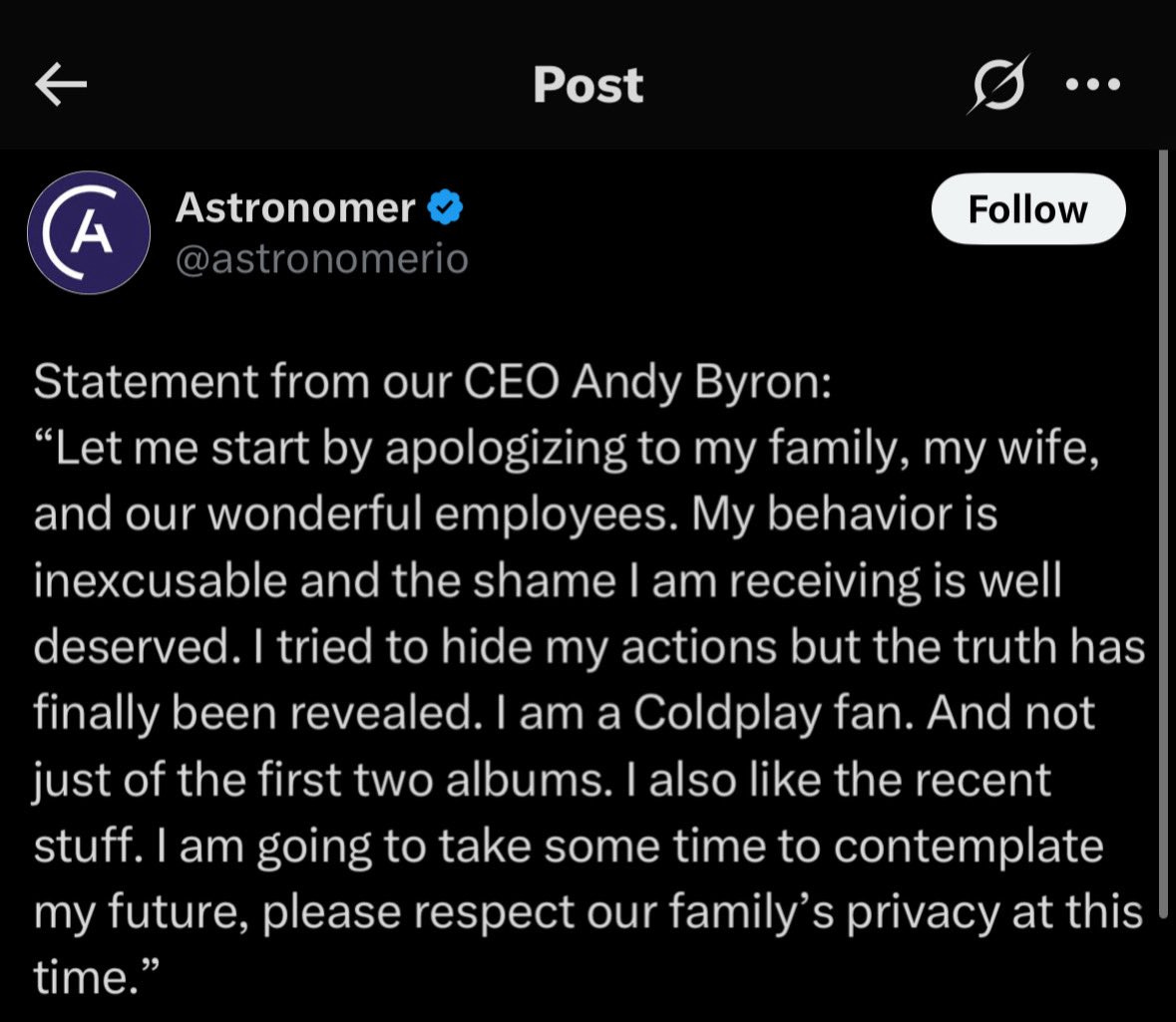
The Viral Moment That Took Down a CEO
A real-time look at how viral content, fake statements, and bot amplification created a perfect storm—and what comms teams need to know now.
It started with a Kiss-Cam and ended with a CEO resignation. The Astronomer incident is a case study in how quickly online narratives can spiral, how easily manipulated content can go viral, and why comms teams must be prepared from the very first post.
Just before 1:00 a.m. on July 17, TikTok user @instaagraace posted a video from a Coldplay concert showing two individuals awkwardly avoiding the Kiss-Cam. They were quickly identified as Astronomer CEO Andy Byron and Chief People Officer Kristin Cabot in what appeared to be an intimate moment. The video took off, amassing over 120 million views.
From there, the incident exploded:
- 848,813 mentions on X
- 31,809 news stories
- Coverage across more than 15 languages
- Estimated reach of 458 million
The Fake Apology Letter
By midday on July 17, a fake apology letter—allegedly from the CEO—was posted by a now-suspended parody account impersonating a CBS News reporter. Though labeled as a parody, the post gained traction and was widely taken as real, quickly spreading across social media and contributing to the narrative amplification:
- 6,600 posts on X alone
- A full day of confusion before it was widely debunked on July 18
- Many posts remained live or were reshared by major accounts before being corrected or removed by July 19
This created a window where a fake statement became the perceived truth, amplified by users, misunderstood by viewers, and nearly picked up as fact by some outlets.

Virality Timeline
This wasn’t a slow burn. It was a digital flashpoint.
- The first Reddit post appeared at 12:48 a.m. ET on July 17
- The earliest TikToks were posted just after midnight, with Grace’s viral post of the evidence landing at 12:56 a.m. ET
- Mentions of Andy Byron began appearing on X around 4:24 a.m. ET and spiked rapidly after 6:49 a.m., peaking at 10:54 a.m. ET
- The highest moment of narrative virality hit at 11:00 a.m. ET on July 17, with 30,000 posts per hour on X
- A second spike followed around 9:00 p.m. ET on July 18, reaching 25,000 posts per hour
Synthetic Amplification
PeakMetrics’ analysis showed the spread wasn’t entirely organic.
More than 40,000 posts sampled were classified as likely or almost certainly bot-driven, meaning inauthentic accounts were amplifying the narrative alongside genuine users.
This kind of synthetic amplification distorts perception, accelerates narrative spread, and can influence how media outlets frame the story.
Our Take
The Astronomer CEO saga reveals several critical realities about today's information environment:
- Nothing in public is private anymore.
As this incident showed, any public behavior can be captured, uploaded, and dissected within minutes. Identifications happen fast, and anonymity rarely lasts beyond the first viral post. - Misinformation and disinformation are the new normal.
Communications teams should not be surprised when fake content emerges during a crisis; they should expect it. Accounts may look credible, even when they’re clearly labeled as parody. The fake CBS News post is a clear example of how quickly disinformation can take hold.
There is growing appetite for anti-corporate content—and CEOs are increasingly targets.“Without an immediate response from the comms team, that fake statement became a perceived source of truth,” PeakMetrics CEO Nick Loui shared with Axios.
“It was clipped, reshared, reframed across platforms, and even picked up by some mainstream news coverage before it was debunked. Once this kind of content takes off and isn't quickly corrected, it becomes incredibly difficult to unwind.”
“That's sort of the bread and butter of clickbait content—laughing at people's poor decisions—and the fact that then it plays into an anti-corporate element just further fanned the flames,” said Molly Dwyer, Director of Insights at PeakMetrics, in an interview with Business Insider.“It was sort of a perfect storm of things that are really viral on social media right now, all coming together.”
Bottom Line
The modern internet rewards speed, outrage, and spectacle. For communications teams, that means having a plan not just to monitor what's happening, but to understand it, detect what’s real versus manipulated, and respond fast with clarity and truth.
At PeakMetrics, we help teams do just that—surfacing emerging narratives in real time, flagging manipulated content, identifying bot-driven activity, and equipping you with AI-generated talking points and response plans. Request a demo.
Sign up for our newsletter
Get the latest updates and publishings from the PeakMetrics investigations team.